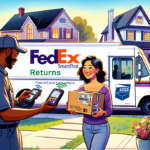Understanding FedEx SmartPost
FedEx SmartPost is a shipping solution that combines the efficiency and reliability of FedEx with the cost-effectiveness of the United States Postal Service (USPS). Designed primarily for e-commerce businesses, it enables the delivery of packages to residential addresses at lower costs while maintaining dependable service. This article explores the workings of FedEx SmartPost, its advantages and disadvantages, tracking features, costs, delivery timelines, and how it compares to other shipping carriers. Additionally, we'll provide strategies to optimize your shipping process using FedEx SmartPost.
How FedEx SmartPost Differs from Standard FedEx Services
Delivery Process and Timeframes
FedEx SmartPost integrates FedEx's network for initial transportation and leverages USPS for the final mile delivery. This collaboration results in longer delivery times compared to standard FedEx services. Typically, packages arrive within 2-7 business days, depending on the destination, which is slower than FedEx Ground or FedEx Express options.
Weight and Size Limitations
FedEx SmartPost accommodates packages up to 70 pounds and a maximum combined length and girth of 130 inches. In contrast, standard FedEx services handle packages up to 150 pounds with a maximum length and girth of 119 inches. Businesses shipping larger or heavier items may prefer standard FedEx or alternative carriers.
Advantages and Disadvantages of FedEx SmartPost
Pros
- Cost-Effective: Offers lower shipping rates, especially for lightweight and non-urgent packages.
- Reliable Delivery: Most packages arrive on time and in good condition.
- Package Tracking: Provides tracking from shipment to delivery, enhancing transparency.
- Flexible Delivery Options: Includes home delivery and delivery to FedEx locations for added convenience.
Cons
- Slower Delivery: Takes longer than other FedEx services due to the USPS handoff.
- Potential Delays: Final delivery by USPS can occasionally result in delays.
- Size and Weight Restrictions: Limited to packages under 70 pounds and specific dimensions.
- Not Ideal for Time-Sensitive Shipments: May not meet urgent delivery requirements.
Tracking and Managing Your FedEx SmartPost Shipments
How to Track Your Package
Tracking a FedEx SmartPost package is straightforward. Use the tracking number provided at the time of shipment on the FedEx Tracking Page to monitor your package's status. Once the package is handed over to USPS, you can also track it via the USPS Tracking Page.
Notifications and Updates
Sign up for email or text notifications through your FedEx account to receive real-time updates on your package’s progress. This feature ensures you and your customers stay informed about delivery statuses and any potential delays.
Costs Associated with FedEx SmartPost
Shipping Rates
FedEx SmartPost offers competitive pricing based on package weight, size, and destination. Generally, it is more affordable than standard FedEx services, making it suitable for businesses aiming to reduce shipping expenses. High-volume shippers may qualify for discounted rates, further enhancing cost savings.
Delivery Assurance
Despite the lower costs, FedEx SmartPost maintains reliable delivery times, typically within 2-7 business days. This balance between cost and reliability makes it an attractive option for many e-commerce businesses.
Optimizing Your E-Commerce Shipping with FedEx SmartPost
Eligibility and Setup
To use FedEx SmartPost, ensure your business has a FedEx account and that your packages meet the service's size and weight criteria. Once eligible, select FedEx SmartPost as your shipping option during order processing. Integration with online marketplaces like Amazon and eBay is also supported, streamlining your shipping workflow.
Maximizing Efficiency
- Package Sizing: Use appropriately sized packaging to minimize shipping costs.
- Scheduling Pickups: Regularly schedule FedEx pickups to ensure timely shipments.
- Utilize Tracking Tools: Leverage FedEx’s tracking and reporting tools to monitor shipments and identify areas for improvement.
Customer Communication
Keep your customers informed by providing tracking details and estimated delivery dates. Responsive communication builds trust and enhances the overall customer experience.
Common Challenges with FedEx SmartPost and Solutions
Delivery Delays
Delays can occur during the USPS final delivery phase. Mitigate this by setting realistic delivery expectations with customers and providing accurate tracking information.
Lost or Damaged Packages
Ensure packages are properly labeled and packaged to prevent loss or damage. Consider purchasing additional insurance for valuable shipments to safeguard against unforeseen issues.
Address Accuracy
Double-check all shipping information before dispatch to avoid delivery failures. Utilize address verification tools to ensure completeness and accuracy.
FedEx SmartPost vs. Other Shipping Carriers
Comparative Overview
While FedEx SmartPost is a viable option for cost-effective shipping, other carriers like UPS and USPS offer similar services. It’s important to compare rates, delivery times, and service features to determine the best fit for your business needs.
Using Shipping Aggregators
Consider using shipping aggregators such as Shippo to compare rates across multiple carriers. This approach can help you find the most economical and efficient shipping solutions tailored to your specific requirements.
Conclusion
FedEx SmartPost offers a reliable and affordable shipping solution for e-commerce businesses, particularly those handling lightweight and non-urgent packages. By understanding its operational framework, leveraging its tracking capabilities, and optimizing your shipping strategies, you can enhance your delivery process and customer satisfaction. However, it's essential to weigh the benefits against the potential limitations, especially regarding delivery speed and package size restrictions, to ensure it aligns with your business objectives.
For businesses shipping larger or heavier items, exploring alternative carriers or shipping methods may prove more cost-effective and efficient. Always consider the specific needs of your business and your customers to choose the best shipping strategy.






















